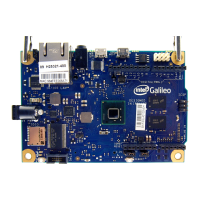Hardware 10
Hardware
2.1: External Outputs
When using a Galileo, the chip itself doesn’t have a lot ways to interact with the outside world. In order to
make your Galileo do some more interesting things, you have to be able to connect external outputs.
‘External’ means it is separate from the microcontroller. The opposite word is ‘internal’. In the previous
lesson, you made the ‘internal’ LED (on the physical Galileo board) blink.
‘Output’ is something that the microcontroller can tell to do something. You can see an output light up,
move, or do something else. Outputs include motors, LEDs, and light bulbs. It is the opposite of an input,
which tells the microcontroller information based upon something in the outside world.
2.2: Connecting an LED
We have made an onboard (internal) LED light on and o on our Galileo, but now we have to start going ‘o
the board’. This means we have to provide a path from the microcontroller to the external LED and back. If we
were going to move cars back and forth, we would build a road. If we were moving water, we would make a
pipe. We are moving electricity so we need a path made of metal, which electricity can travel across. Metal
is a great conductor like you learned in Circuitry Lessons.
An easy way to connect electronic components is to use rubber-coated electrical wire. The
rubber prevents electricity going in a way we don’t expect. And the metal wire conducts
electricity across it.
To connect things we rst have to take a piece of wire, however long makes sense to you, and remove the
rubber from the ends of both sides. Take o enough to work with easily. This is called “stripping the wire”.
We are going to use the Blink program again (If you lost it or don’t have it, open le->examples->01. Basic-
>Blink). This program communicates through pin 13. That means we have to insert our wire into pin 13 (Lesson
2, Figure 1).
2: Make your Galileo Blink Some More
Lesson 2 Figure 1
metalwires
rubber

